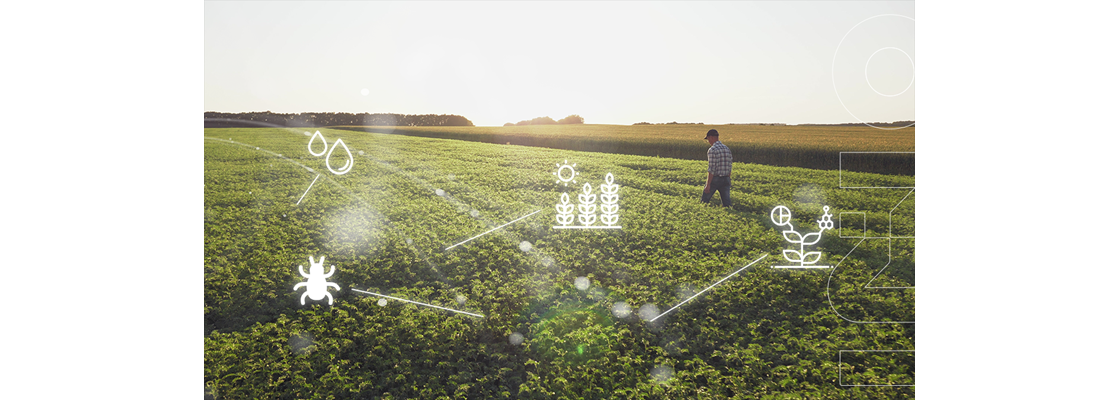Precision farming is revolutionizing the agricultural industry by allowing farmers to collect data on their crops using optical sensors, providing accurate plant and soil information to improve agricultural productivity, sustainability and profitability.
In this blog post, we explore the main optical technologies used in agriculture. We examine how these technologies work, how they can be used to collect crop data, and how this data can be used to optimize agricultural production.
RGB (Red Green Blue) sensors
These are optical sensors that record images in three colour bands: red, green and blue.
This type of sensor is used to map vegetation and measure plant leaf colour, providing information about the plants’ yield, health and maturity status. Healthy plants have a brighter green colour, while stressed or diseased plants may have a duller or yellowish colour.
These sensors also map vegetation at different growth stages, helping farmers identify areas where crops need special attention. The data collected can be combined with other types of data, such as weather, temperature and soil fertility data, to create predictive models and optimize agricultural production.
Hyperspectral sensors
A hyperspectral sensor measures light reflectance at several wavelength bands, from visible to near infrared. Unlike an RGB sensor that measures only three colour bands, a hyperspectral sensor measures several dozen or hundreds of narrow, adjacent wavelength bands. These images can help identify and map specific materials on the Earth’s surface, such as minerals, soils and vegetation.
Hyperspectral sensors are used to obtain detailed information about plants’ chemical composition, health and level of maturity. The data collected is used to map crop properties, such as leaf density, water and chlorophyll content and soil nutrient concentration.
To learn more about the features of hyperspectral sensors, read the blog post Predicting the shelf life of leafy greens.
Multispectral sensors
This type of sensor measures the reflection factor of light at several wavelength bands, but with a smaller number of bands than a hyperspectral sensor. Typically, a multispectral sensor measures between 4 and 10 wavelength bands.
Multispectral sensors can obtain information on plant health and vigour, level of contamination (animal feces), the presence of foreign bodies (insects, stones) and level of maturity. Although they have a spectral resolution lower than that of hyperspectral sensors, multispectral sensors provide relevant complementary information to help farmers make informed decisions and optimize crop production.
Infrared sensors (IR)
These sensors measure the electromagnetic radiation emitted or reflected by the crops in the infrared spectrum. They can measure different wavelengths in the infrared spectrum, including near infrared (NIR) and far infrared (FIR).
Infrared sensors are often used to measure crop temperature, providing information about plant respiration and growth. Infrared sensors can also measure the crops’ moisture content, as the moisture content of leaves can affect their ability to reflect or emit infrared radiation.
These sensors provide accurate information to farmers to help them make informed decisions and optimize crop production by measuring the temperature and moisture content of crops.
LiDAR sensors
LiDAR (Light Detection and Ranging) is a sensor that uses laser pulses to measure the distance between the laser transmitter and a reflective surface, such as soil or plants. It is used to map field topography, crop height and canopy density.
LiDAR can be mounted on a drone, land vehicle or aircraft to collect large-scale crop data. The collected data is used to create high-resolution three-dimensional crop maps, allowing farmers to visualize height differences in fields, areas of low crop cover and areas of water stress.
LiDAR data is also used with multispectral or hyperspectral sensor data to provide additional crop information, such as leaf density, chlorophyll content and moisture content.
Discover an example of how LiDAR sensors are used in the agricultural field by reading the case study Detecting More than Fill Levels in Farmers’ Bins with Machine Vision.
In conclusion, optical sensors are playing an increasingly important role in agriculture, allowing farmers to collect precise data on crops, including the measurement of water content, leaf density, chlorophyll content, crop height and field topography.
These sensors are often mounted on drones or satellites to perform large-scale crop surveys. Image processing and machine learning techniques using artificial intelligence algorithms process the data collected to identify crop areas that require special attention, optimize farming practices such as irrigation, fertilization and disease and pest management, increase yields and improve crop productivity.
Sensors such as infrared, multispectral, hyperspectral and LiDAR sensors each offer unique advantages in crop data collection. By combining data collected from multiple sensors, farmers have a more complete understanding of the growing conditions of their crops, helping them make more informed decisions to optimize productivity.
To see an example of the use of optical sensors in the agricultural sector, download the case study Development of a Portable Spectrometer to Analyze Potato Plant Nutrient Deficiencies.



